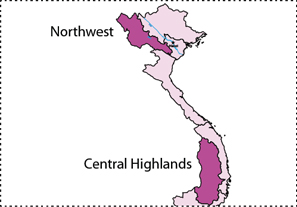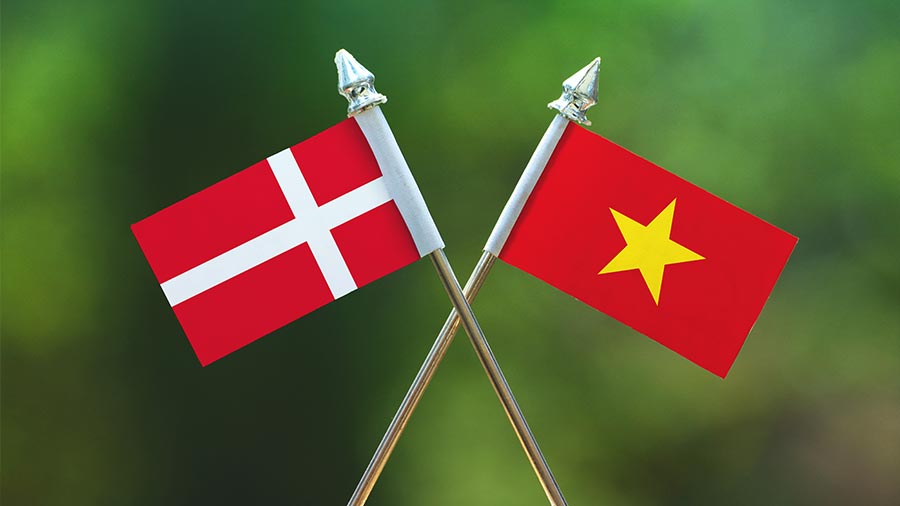Regional Spotlight: Vietnam’s Northwest and Central Highlands
 Apr. 17 – Vietnam’s Northwest and Central Highlands have recently gained prominence as increasingly important developmental regions. Only last month the Bank of Investment and Development of Vietnam (BIDV) pledged to provide VND 15 trillion (US$718 million) and VND 7.5 trillion (US$359 million) to the respective regions between 2013 and 2015. This presents itself as a further incentive for investors to investigate the opportunities these localities can provide.
Apr. 17 – Vietnam’s Northwest and Central Highlands have recently gained prominence as increasingly important developmental regions. Only last month the Bank of Investment and Development of Vietnam (BIDV) pledged to provide VND 15 trillion (US$718 million) and VND 7.5 trillion (US$359 million) to the respective regions between 2013 and 2015. This presents itself as a further incentive for investors to investigate the opportunities these localities can provide.
Northwest
Large urban centers are missing from the Northwestern region, with Hoa Binh being the largest town. However, the region produces about one third of the total hydro-electric power of Vietnam, with the Son La Plant being the largest single producer.
 RELATED: Dezan Shira & Associates’ Pre-Investment, Market Entry Strategy Advisory Services
RELATED: Dezan Shira & Associates’ Pre-Investment, Market Entry Strategy Advisory Services
While the region is currently one of the poorest in Vietnam, it holds a lot of business potential, particularly in terms of its natural resources.
Geography
The region is bordered by Laos to the west and China to the north. Covered by a number of prominent mountains, the typography includes a 180km long mountain range that cuts diagonally across the region from northwest to southeast. Several peaks along the mountain range reach 3,000 meters, including the so-called “roof of Indochina,” Fansipan Mountain.
Industries
Due in large part to the relatively cold climate in the northwest (the region is called “Tay Bac” in Vietnam), the land is suitable for the cultivation of many products such as tea, medicinal and aromatic herbs, and fruits. The region is also rich in minerals, with large stocks of granite, limestone, coal, clay and various other minerals such as iron and gold.
Infrastructure
The government is investing in the expansion of border beltways, as well as interregional and intraregional roads to link remote, mountainous communes with the national grid. Rivers make up more than 150km of inland waterways in the region, built around a set of important river ports, such as Tua Chua and Muong Lay.
The Northwestern region is served by two airports: Dien Bien Phu Airport (the biggest in the area, with international flights to both Laos and China) and Na San Airport at Son La City (which has daily flights to Hanoi and other major Vietnamese cities, such as Ho Chi Minh City and Da Nang.)
Central Highlands
The Central Highlands’ economy is based heavily on the manufacturing sector, as well as agricultural and forestry exports, which account for 60 percent of the region’s GDP. The region generates a high volume of coffee, sugar, vegetable oil and meat product exports.
Geography
The region is bordered on the west by Cambodia, and on the northwest by Laos. The region’s landscape varies, with high mountain ranges and abundant plains. The mountainous area accounts for 35 percent of the natural area and, in the central provinces, there are mountain peaks with an average elevation of 1000-1200m. In addition, the network of streams and rivers is quite extensive, along with waterfalls and more than 500 natural and man-made lakes.
Industries
The region has relatively few mineral resources, but has proven deposits of modest quantities of chromium, nickel, cobalt, tin, arsenic, lateritic bauxite and gold. The region’s highly fertile arable land is ideal for industrial cultivation of crops such as coffee, rubber, cotton and cocoa. Fruits and vegetables are also grown in large quantities. Tay Nguyen, and Dak Lak province in particular, is often referred to as the “capital of coffee”, as the region has the largest coffee growing area in Vietnam.
The production of construction material is another significant sector, as Tay Nguyen has an abundance of limestone, granite lumber, rubber and latex. The region also produces a significant amount of cement. Tay Nguyen’s various attractions have yet to be fully developed into a thriving tourism industry as is seen in other regions of the country. The exception is Da Lat, a major city that attracts a lot of tourists due to its scenery, weather and exotic flowers (often labeled “the Switzerland of Southeast Asia”).
Power Production
The Central Highland’s landscape of mountains, rivers and streams is dotted with small and medium-sized hydropower plants. Energy needs are generally satisfied by the region’s own hydropower plants.
Infrastructure
The highway system connecting the Central Highlands and Central Coast is very convenient for transporting goods to ports for exporting. Tay Nguyen is served by three airports with connections to major domestic cities. Pleiku Airport is relatively small operating domestic flights by Vietnam Airlines only, Phu Cat Airport is used both commercially and by the Air Force, and Buon Ma Thuot Airport in Dak Lak province operates daily flights between Da Nang and Ho Chi Minh City.
 Material for this article was taken from the May 2012 issue of Vietnam Briefing Magazine, titled “Vietnam’s Provinces, Regions, and Key Economic Zones,” which is available as a PDF download on the Asia Briefing Bookstore. In this issue, we discuss the industries and economy of Vietnam’s three levels of geographic divisions from the perspective of a potential foreign investor.
Material for this article was taken from the May 2012 issue of Vietnam Briefing Magazine, titled “Vietnam’s Provinces, Regions, and Key Economic Zones,” which is available as a PDF download on the Asia Briefing Bookstore. In this issue, we discuss the industries and economy of Vietnam’s three levels of geographic divisions from the perspective of a potential foreign investor.
Dezan Shira & Associates is a specialist foreign direct investment practice, providing corporate establishment, business advisory, tax advisory and compliance, accounting, payroll, due diligence and financial review services to multinationals investing in emerging Asia. Since its establishment in 1992, the firm has grown into one of Asia’s most versatile full-service consultancies with operational offices across China, Hong Kong, India, Singapore and Vietnam as well as liaison offices in Italy and the United States.
For further details or to contact the firm, please email vietnam@dezshira.com, visit www.dezshira.com, or download the company brochure.
You can stay up to date with the latest business and investment trends across Vietnam by subscribing to Asia Briefing’s complimentary update service featuring news, commentary, guides, and multimedia resources.
Related Reading
 An Introduction to Doing Business in Vietnam
An Introduction to Doing Business in Vietnam
This new 32-page report touches on everything you need to know about doing business in Vietnam, and is now available as a complimentary PDF download on the Asia Briefing Bookstore.
- Previous Article Vietnam International Trade Fair Opens
- Next Article Tax Update: Vietnam Gov’t Approves Amendments to CIT Law































